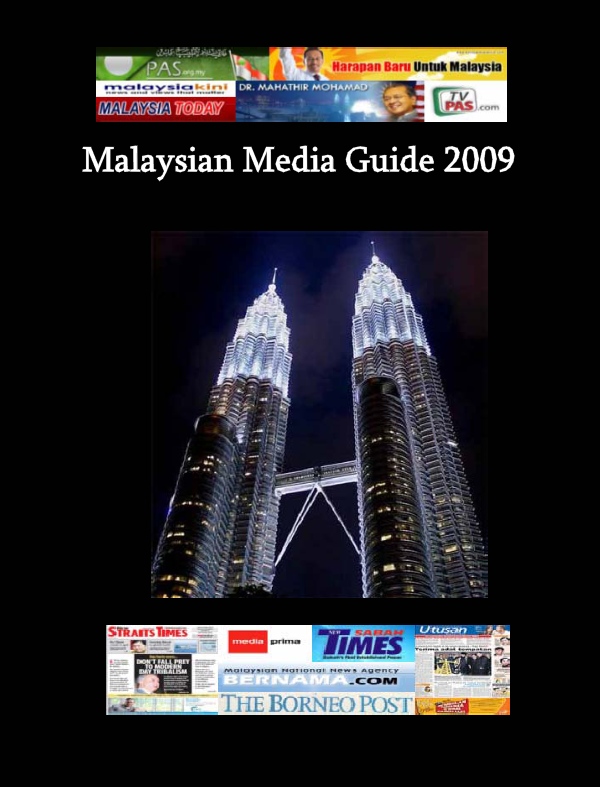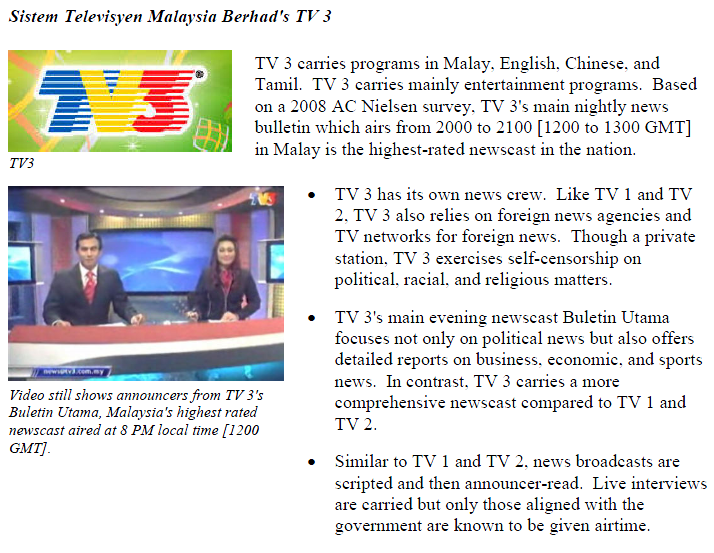Open Source Center Media Aid
- 36 pages
- For Official Use Only
- March 25, 2009
Malaysia’s mainstream media are state controlled through indirect ownership of media conglomerates and closely adhere to the government line. Some mainstream outlets, especially Chinese newspapers, raise contentious issues such as the treatment of the country’s predominant Malay and minority Chinese and Indian communities.
Newspapers are the preferred choice for political news, but TV and radio have nearly twice the audience, with about 90-percent reach, compared to 50 percent for newspapers. Internet use is increasing, and alternative news portals and blogs provide an important venue for dissent and criticism despite government defamation suits against bloggers and the use of the Internal Security Act.
Most Islamic media are of a religious nature, free of political comment. Islamic materials that diverge from this baseline generally appear to have originated in Indonesia.
2. Mainstream Media Typically Owned by Government-Affiliated Individuals, Groups Despite the growing popularity of online media, mainstream media remain the predominant source of information for most Malaysians. Mainstream media can be classified as media sanctioned by the government, typically in the form of being granted a license to publish or air content to a mass audience on a daily basis.
- Malaysia’s mainstream media consist of wide ranging sources in the form of TV channels, newspapers, and radio stations which serve the multiple ethnic groups of Malaysia — the Malay, Chinese, and Indian communities.
- The linguistic diversity in Malaysia’s mainstream media is reflected in the range of newspapers available — four English-language dailies, four Malay-language dailies, six Chinese-language dailies, and two Tamil-language newspapers. TV programming offers a similarly diverse mix.
- Despite the surface diversity, Malaysia’s mainstream media are consolidated in the hands of a small number of privately owned conglomerates with close links to the political establishment — interlinking ties that result in a mainstream media which closely toes the government’s line. Mainstream media outlets typically feature similar leading stories on a particular day.
- Certain opposition-linked publications like Harakah — the official newspaper of the opposition Parti Islam SeMalaysia (PAS) — are not considered mainstream media as they are not published regularly and always at risk of having their licenses canceled. Mainstream media do not face such uncertainty because they are typically either linked politically or through business interests to the government.
2.1. Ethnic Audience Influences Mainstream Media
Although mainstream media in Malaysia closely track with the government line, criticism — often limited to statements attributed to opposition figures — does surface in mainstream media. The level of criticism tends to vary according to the ethnic segmentation of the media.
- Malay newspapers are the most pro-government and critical of the opposition. Opposition criticism is presented within the context of a rebuttal or outright rejection by a government official in the very same report. Malay newspapers are also known to champion the rights of ethnic Malays and strongly defend the affirmative action policy — the controversial New Economic Policy (NEP) — which gives special economic, social and educational privileges to Malays.
- English-language newspapers similarly adhere to the government line but attempt to be more inclusive by airing views of all ethnic groups. This may be because English-language dailies can be widely read by members of all groups in the country. Views of opposition members are aired in English-language newspapers but are often limited to certain selective statements which typically soften criticism of the government.
- Chinese-language newspapers are the most critical of the government. Much criticism focuses on the dissatisfaction of the ethnic Chinese community toward government policies. Despite that general stance, Chinese-language newspapers are part of the mainstream media as they are licensed and published daily for a mass audience.
- Tamil-language dailies, with smaller circulation, serve the Indian ethnic group and focus more on highlighting community issues.
…


